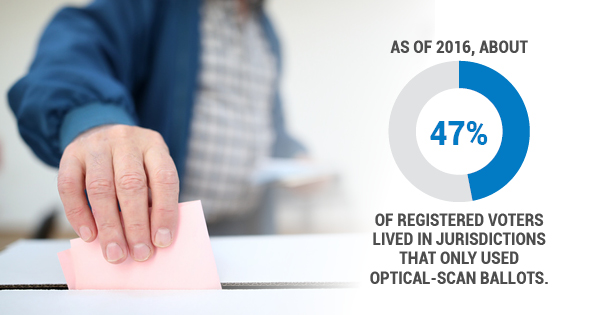
Your Vote Counts: Know How Ballot Scanners Count Them
The midterm elections in November are quickly approaching, putting voting at the forefront in the minds of people across the United States. Americans have a major opportunity to vote every two years, as well as all of the primaries and local elections in between. An informed public can make informed decisions, so make sure you know how the ballot scanner records your vote before you cast it.
How America Votes
As of 2016, about 47% of registered voters lived in jurisdictions that only used optical-scan ballots. These are the voting scanners that probably come to mind when you think of voting. Voters fill in bubbles, complete arrows, or make other machine-readable marks on paper ballots. About 28% of voters live in jurisdictions that only use direct-recording electronic (DRE) devices. These devices are often touch screens that record votes in computer memory. Another 19% of voters live in jurisdictions where both systems are used. The remaining 5% of voters live in areas that conduct elections completely by mail. In upwards of 1,800 small counties, cities, and towns, they don’t use any kind of ballot scanner and instead count paper ballots by hand. Optical-scan ballots remain the popular choice largely because many people do not trust that DRE equipment would make a paper trail for future recounts, and that was true for about three-quarters of the jurisdictions who used DRE-based systems.
A Short History of Recording Votes
Before the advent of image scanner technology, Americans first voted by going to the appointed voting location and shouting out their vote. They registered to vote simply by swearing an oath in front of a judge and witnesses, rather than the more extensive registration today that typically requires having a form of ID and filling out paperwork. As of 2015, about 218 million people in the United States had driver’s licenses, making voter registration a possibility for much of the country, but these forms of ID did not exist when the voting process was established, and of course, many people did not have the right to vote. In 1892, the first lever voting machine was used in Lockport, New York, and by the 1930s it was widely used for voting across the country’s urban centers. Although lever machines remained the standard until the late 1970s, the punch-system of voting and optical-scan ballots were first developed in the early 1960s. DRE devices were developed in the early 1990s, and with optical scan systems, they effectively replaced almost every other ballot scanner.
As we have developed the license scanner and passport scanner to verify the validity of someone’s ID, we have needed to develop efficient ballot scanners to properly record the votes of citizens. These methods will surely keep evolving as our technological advances keep coming.
